Day 2
May 5, 2003
(Monday)
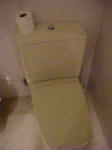
The toilet in our Barcelona hotel room (you flush by pulling up on the
knob)
10:10 am
We awake in Barcelona, in the Hotel Colon after a nice 11-hour nap, and head
downstairs to the hotel cafe (motto: "From our Colon to yours!") for breakfast.
The breakfast buffet emphasizes that we are in a Foreign Country).
Not only are there no donuts (!), but the cream for the coffee is some kind
of warm brown milk. Also the buffet includes olives, and a huge bowl of whole,
fresh tomatoes. Fortunately, our Spanish is up to the task ("mas cafe!
mas cafe!") and we manage to stuff ourselves.
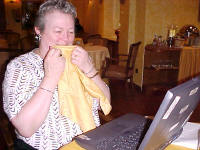
Laura edits the Trip Log while eating breakfast (she thinks this part
is especially funny)
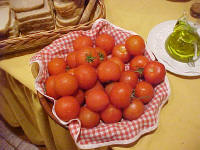
This bowl of fresh tomatoes was part of the breakfast buffet
Attention
The following paragraph is intended for Adolescent Males (of all ages and
genders). If you are an actual grownup, please skip this section.
We were then eliminated by the Hotel Colon onto the surrounding avenue, where
we stood digesting our surroundings. We got the poop on the local tours from
the Colon, and as we were passing out of the Colon, we felt a little brown
around the edges.
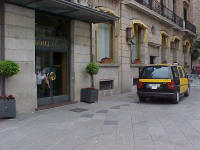
The sphincter of the Colon
11:49 am
The Hotel Colon is in the Gothic Quarter directly across the street from
"The Cathedral" (The Cathedral of St. Eulalia), which is what everybody calls
this High-Gothic church, which was built starting in the late 1200's and
finished about fifty years before Columbus set sail (apparently it took their
Building Committee a while to raise the money).
In other words, everything we saw was older than anything in the US (with
the possible exception of Strom Thurmond).
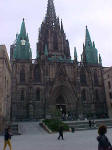
The Cathedral outside our hotel

Panorama outside the Hotel Colon
Inside the cathedral, the nave is surrounded by many chapels, each about
12 feet square with an elaborate painted or sculptured altarpiece. The sculptures
are sometimes of one of the apostles, more often of a Spanish Saint, and
sometimes of a bishop (Rank Has Its Privileges). The paintings and statues
are stunning, and frequently a thousand years old.
Each altar has a set of bars across it, making it look like the church has
locked up a bunch of miscreants for poor behavior. The reality, of course,
is to protect the saints from us.
The inside of the cathedral is massive. At the entryway, there are two rows
of pillars that are about 10 feet in diameter. As they progress towards the
altar, the diameter of the columns gets smaller until they are "only" five
feet across.
This is a working Roman Catholic church and we pass by a confessional where
a priest is hearing somebody's confession (which was fortunately in another
language, saving us the inconvenience of eternal damnation for eavesdropping
on a confession). Various parishioners are lighting candles and saying prayers
in front of their favorite saint/apostle/bishop.
12:15 pm
We continue walking around the cathedral and we happen across a small alleyway
with an alcove. There, behind a gate, are a couple of pillars from the Roman
temple at Barcelona, built near the end of the first century BC. In other
words, these babies were already old when Jesus walked the earth, which made
us feel fairly young by comparison.
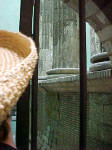
Laura looking at ancient Roman ruins
As we were walking down the alley, we chanced across a Spanish guitarist
sitting on a chair in the alley, playing classical Spanish guitar music.
The echo from the 10 foot high stone walls was really cool and the effect
was lovely. We gave him some money to encourage him to keep doing this.
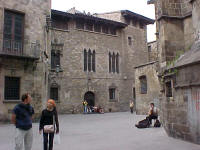
A Spanish guitarist plays in an alley
Note about money
Much of Europe has switched to using "Euros" (€ is the symbol) rather than
every country having their own flavor of money. A Euro is about a buck ($1.19
last we checked, but close enough). The Euro is much prettier than US money.
Britain is still backwards though, and uses pounds, shillings, ducats, and
shekels.

Panorama of the plaza
We decide to find a tour bus and get the nickel tour of the rest of Barcelona,
so we walk towards the Plaza Catalunya. There's a plaza about every two blocks
here, and the two blocks to this plaza is a wide pedestrian boulevard, which
is jammed with people. Every fifty feet or so is a set of street musicians.
We liked the one that was playing Spanish Dixieland arrangements of Broadway
show tunes.
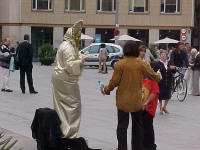
A mime dressed as a golden strange thing with a weird hat
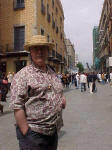
Robert standing in Barcelona
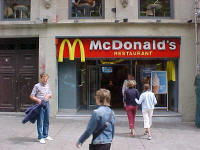
They're everywhere!
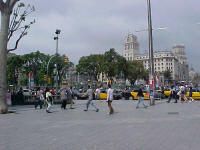
A plaza
12:50 pm
We locate a tour bus called the "Bus Turístic" (with a little uphill accent
on the first "i"). These are double-decker buses with an open top that cruise
around Barcelona. The tour guide is careful to point out (in four languages)
that this is not a tour, because they don't cover everything, and
anybody who was a good human being would spend at least a year or two studying
and admiring everything Catalan, but okay, they would make some accommodation
for tourists.
Note
Technically, we're in Spain, but most folks here think of themselves as
Catalan. They speak Catalan, which is a mixture of Spanish and French. When
the Evil Franco ruled, he suppressed a lot of Catalan culture, so now (of
course) it's roaring back with a vengeance.
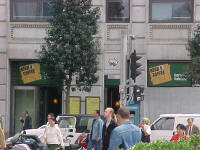
Robert's kind of store: Beer and Coffee (while waiting for Bus Tourístic)
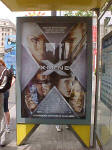
How you spell "X-Men" in Spanish
The nice thing about the buses is that if you see something you like, you
can get off the bus, see it, and then catch the next bus that comes along
to continue.
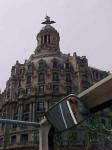
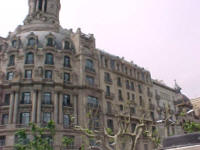
An historical building
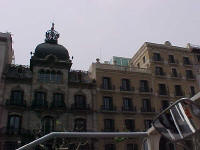
More history
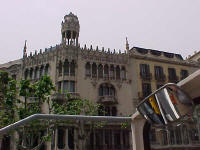
Historical stuff
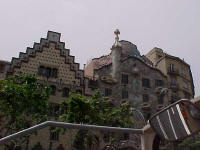
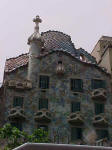
Casa Batllo in Barcelona (Designed by Gaudi for the textile manufacturer
Josep Batllo)
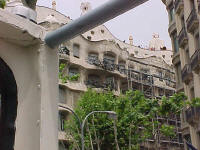
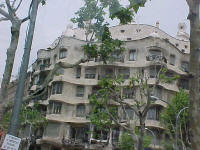
Casa Milla (last and most famous secular building of Gaudi), nicknamed
"Pedrera" (The Pile).
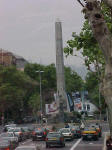
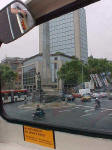
Plaza Rey Joan Carles I (King Johnny Carlos) in Barcelona
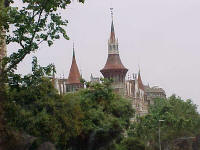
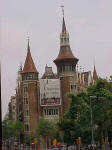
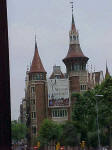
Casa de la Punxes (House of the Punks); built in 1905 (brand new!); the
architect was Cadafach and it's a Private house
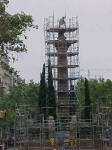
Placa Mossen Jacint Verdagur (an historical statue on a pillar surrounded
by scaffolding near St. Joan)
We decide to get off at a massive edifice known as the Sagrada Familia
or Church of the Holy Family. Everybody in Barcelona says that everybody
else in the world thinks of Barcelona when they see this church. We thought,
"Whoa! That's one big church! Weird looking, too."
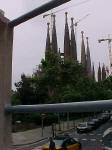
Church of the Holy Family from a distance
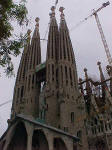
Closer view of Church of the Holy Family
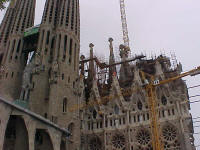
Another view of the church
The deal is that it was designed by a guy named Gaudi about a hundred years
ago. He started work on it, and got pretty far along, but then he got killed
by a bus, which interfered with his ability to oversee the project. Then
his workshop got blown up during the Spanish Civil War, which hindered anybody
else's ability to complete it.
And Sr. Gaudi had some pretty distinct ideas about how the church should
look. For starters, there would be four facades, a different one on each
side. On side is the "Nativity Facade" and features realistic sculptures
of Jesus' early years. The opposite side is the "Passion Facade" which features
square-headed stylized sculptures of the crucifixion. We don't know what
the other two facades will be, because they're not done yet.
The pillars inside are based on tree trunks and as they rise, they tend to
spread out into branches to support the ceiling. Gaudi also did some pioneering
working in using inverted string models to determine the ideal shape for
arches using catenary shapes (just like the St. Louis Arch!).
Anyway, when you get inside, it's all pretty much scaffolding. It takes a
while for us to get our heads bent around what he's trying to do, but the
more we understand the cooler it gets. All the shapes and structures are
very organic (some of them mimic fractals) and there's lots of symbolism
everywhere.
We heard that when you ask the locals when it will be finished, they say,
"Probably never, but maybe next year." The effort is funded entirely by private
donations, and they currently have enough for work to continue.
Gaudi also designed a mess of other weird-looking buildings around Barcelona,
and everybody seems quite proud of him.
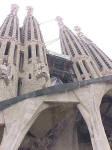
Church of the Holy Family

Panorama of the Passion Facade
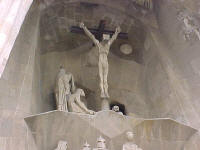
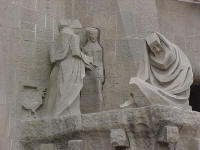
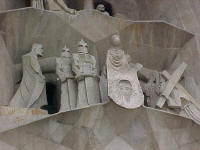
Details of the Passion Facade of the church
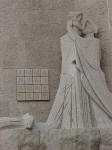
The Judas kiss. In the magic square, all the columns and rows add up to
"33" (Jesus' age when he died)
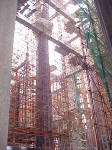
Inside the church
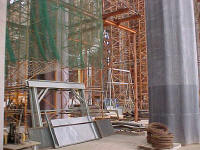
Work continues inside the church
A sign in the church had the following text, which seems to be quotes
from Gaudi (the architect):
"In all architectural styles the column is linked to the concept of the
tree. [...] these comparisons only have a certain amount of abstract
literary value, for the columns and vaults essentially had nothing in
common with the tree, as the latter constitutes an individuality that
survives independently of all that surrounds it, as it has at its
disposal all the elements of equilibrium without the need for assistance
or props, contrary to what happens with the pillars and vaults in a
Gothic cathedral.
"[...] not just a few supports and large vaults, but many supports
separating the vaults, so that we obtain small areas, thus avoiding
damaging sagging, this is the concept of the tree, which is all support.
"The suppression of the buttresses has been achieved simply by giving
the column the inclination of the resultant of the composition of the
weights resting upon it.
"All the shapes and all the resistant elements of the Gothic template
are based on the decomposition of the loads acting upon it, and for this
reason one cannot do away with the buttresses without the building
collapsing.
"Iron, as an auxiliary material has been used (Italian constructions,
the fascines of domes) and will continue to be used, and the more
auxiliary it is the better. Whereas in Italy it has been used as an
exposed strut, it is better to use it as a strut within masses of stone
that protect it and prevent it from buckling through its own weight and
its destruction by unforeseen loads.
"The architect of the future will build imitating Nature, for it is the
most rational, long-lasting, and economical of all methods."
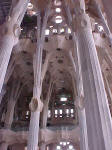
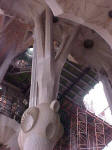
The columns are designed to look like trees and branch out as they rise
upwards
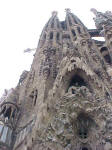
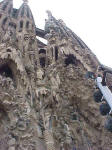
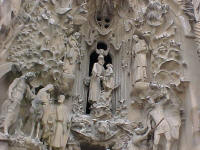
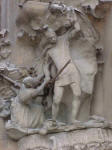
On the Nativity Facade; note the dramatic difference in styles from the
Passion Facade
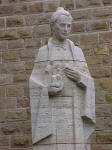
St. Josep Manyanet was the founder of the Sons of the Holy Family, a monastic
order
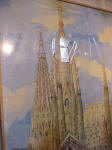
A drawing of what the church should look like when it's done (note the
beams of light coming out of the cross perched on the top)
2:00 pm
We stop for lunch at the El Roacho Coacho across the street from the church.
There, we add to our Spanish vocabulary by learning that hamburger is "hamburguesa"
(although it seems to be made with a sausage patty).
There are bronze-colored Joseph and Mary mimes who are working the crowd
for donations. They are dressed in bronze clothing, with bronze makeup on,
and bronze hair. Mary is carrying a little bronze spray-painted Jesus doll.
Mostly, they stand very still, except when someone tries to take their picture.
Then Joseph uses sign language to indicate that they should fork over some
moolah in exchange for the pix. If the people pay, they get a tiny St. Joseph
medal.
We wonder what this guy puts on his resume....
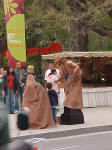
Mary and Joseph working the crowd
2:30 pm
We leap back onto the Bus Tourístic and continue the tour of Barcelona.
There are few really tall buildings. Most of them are four to eight stories
tall, with apartments on the top and stores on the street level. It's really
quite a lovely city.
We also see Europe's Largest Football (soccer, really) Stadium. It seats
100,000 raving fanatical Catalonian fans and we bet the hot dog vendors really
rake it in during a game.
4:15 pm
We collect our luggage from the Colon and get a cab to the "Golden Plincess"
(as the doorman and the taxi driver refer to it). Our driver whips down a
few alleyways (just to let us know that he knows where he's going). We're
almost there, when we get caught by a drawbridge going up to let another
cruise ship through. The driver is distressed by the wait, but we try to
explain that in our part of the world, getting caught by the drawbridge is
a regular occurrence (and a convenient excuse for tardiness).
While waiting, we catch sight of our ship, and it's a monster. This thing
is frelling huge. It looks like somebody took a 60-story apartment
building and laid it on its side. The lifeboats on the side are 30 feet long
and look like little rafts.
According to the stats, it's 900 feet long, which doesn't sound like much
until you realize that that's about 1/5 of a mile! It can carry 2,600 passengers.
It doesn't have a proper smokestack, though. Just a bunch of little pipes
coming up near the back.
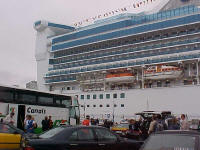
Our boat is huge!
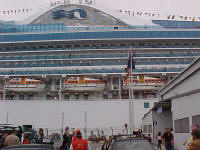
Really huge!
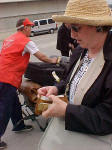
Laura fusses with her money while our luggage disappears
5:00 pm
We pass through all the various checks to get on board (including filling
out a form that asks us if we have SARS or have visited Toronto in the last
10 days). They carefully X-Ray our carry-on luggage, but don't seem phased
by Robert's deadly sandal shanks or Laura's Ninja Sewing Kit.
Our Cabin is A502 and is the most un-cabin like cabin either of us have ever
seen. Instead of a tiny porthole (that usually doesn't open), it's got a
lanai (really!). All the rooms have lanais (a lanai is a balcony you can
sit on). Inside it looks like a hotel room.
The bathroom still looks ship-like, though, as it's got exactly enough room
to turn around in, and has a shower slightly smaller than a phone booth.
We turn around inside the shower a few times just to remind ourselves that
we're still on a boat.
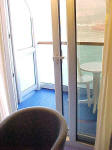
Instead of a measly porthole, we have a lanai!
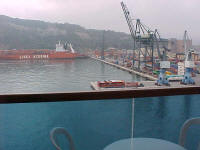
The view from our lanai
6:30 pm
So far, we've located at least six bars on board. We finally settle at one
of the three (!) pool side bars and Robert orders a garbage drink special
(Hurricane? Mai Tai? Whatever it was took out a few brain cells).
7:30 pm
The traditional ship dinner has changed, too. Instead of always eating with
the same people at the same table at the same time, you have a choice. You
can just show up and get a table whenever one becomes available. You can
also get the traditional approach, or head for one of the "theme" restaurants
and get a real meal.
The food is still pretty good, though--at least that hasn't changed. Although
one item on the menu was a soup titled: "Iced Pina Colada Cream Splashed
With Rum."
Signing off from the Golden Princess in Barcelona, Catalan, Spain
Robert & Laura
|
